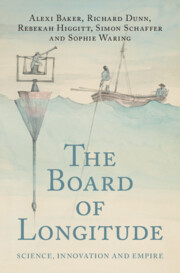Book contents
- The Board of Longitude
- The Board of Longitude
- Copyright page
- Dedication
- Contents
- Figures
- Tables
- Boxes
- Acknowledgements
- Timeline
- Abbreviations
- 1 Introduction
- 2 Sailing the Oceans and Seeking Longitude before 1714
- 3 Launching the Eighteenth-Century Search for Longitude
- 4 The Early Commissioners in Transition
- 5 The Birth of the Board of Longitude
- 6 Time Trials
- 7 Manufacturing the Nautical Almanac
- 8 Managing, Communicating and Judging Longitude after Harrison, 1774–c. 1800
- 9 A Practical Institution Weighed Down by Impractical Proposals?
- 10 What Is an Observatory? From the Metropolis to the Cape
- 11 The Death and Rebirth of the Board of Longitude
- Epilogue
- Book part
- Glossary
- Bibliography
- Index
10 - What Is an Observatory? From the Metropolis to the Cape
Published online by Cambridge University Press: 11 April 2025
- The Board of Longitude
- The Board of Longitude
- Copyright page
- Dedication
- Contents
- Figures
- Tables
- Boxes
- Acknowledgements
- Timeline
- Abbreviations
- 1 Introduction
- 2 Sailing the Oceans and Seeking Longitude before 1714
- 3 Launching the Eighteenth-Century Search for Longitude
- 4 The Early Commissioners in Transition
- 5 The Birth of the Board of Longitude
- 6 Time Trials
- 7 Manufacturing the Nautical Almanac
- 8 Managing, Communicating and Judging Longitude after Harrison, 1774–c. 1800
- 9 A Practical Institution Weighed Down by Impractical Proposals?
- 10 What Is an Observatory? From the Metropolis to the Cape
- 11 The Death and Rebirth of the Board of Longitude
- Epilogue
- Book part
- Glossary
- Bibliography
- Index
Summary
This chapter surveys one of the most significant enterprises of the Committee of Instruments and Proposals, established by the Board of Longitude following the Longitude Act of 1818. This was the management of a new observatory proposed for the Cape of Good Hope. Several Commissioners of Longitude had direct interests: John Barrow had been administrator and surveyor at the Cape; Joseph Banks advised on maritime surveys there; Davies Gilbert lobbied actively for a southern equivalent of the Royal Observatory. Commissioners successfully negotiated the scheme with the Admiralty and the Colonial Office. Though funds were forthcoming from the Navy, long-distance management proved difficult. The resulting issues reached the Committee and the Board, as did increasing costs of equipment from London’s finest instrument makers. These challenges had not been resolved at the Board’s dissolution in 1828; indeed, that moment coincided with discussions as to the possibility of closing the observatory. The affairs of the Cape Observatory thus reveal both opportunities and challenges in issues of scientific and geographical management in the epoch of empire and reform.
Keywords
- Type
- Chapter
- Information
- The Board of LongitudeScience, Innovation and Empire, pp. 229 - 251Publisher: Cambridge University PressPrint publication year: 2025

